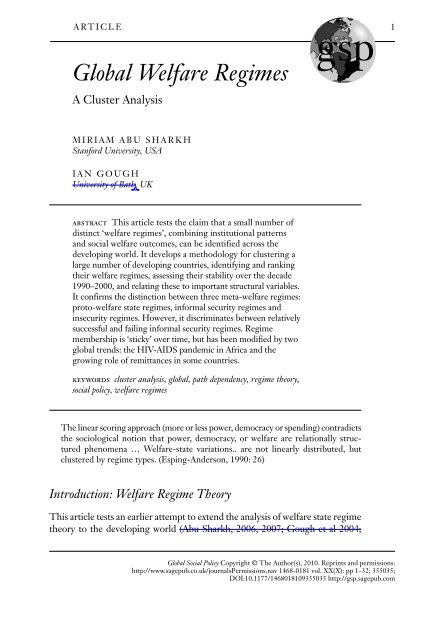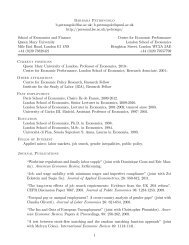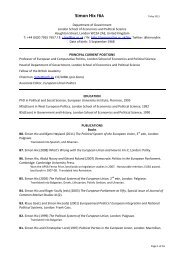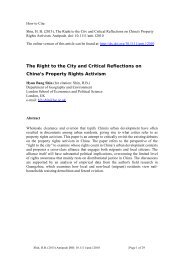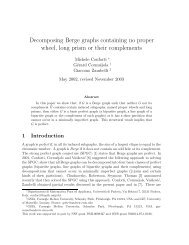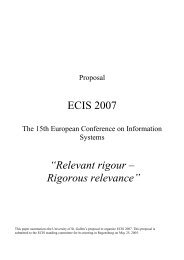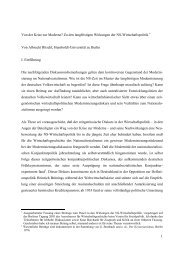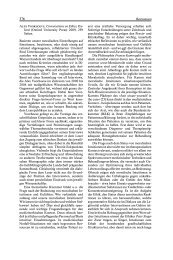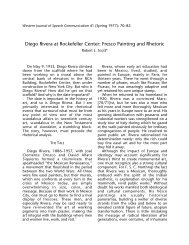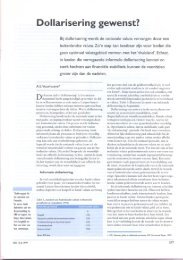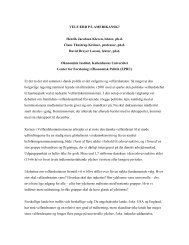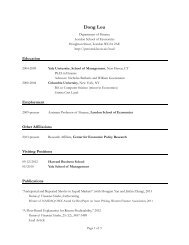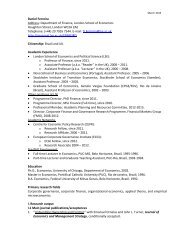Abu Sharkh and Gough GSP.pdf - LSE
Abu Sharkh and Gough GSP.pdf - LSE
Abu Sharkh and Gough GSP.pdf - LSE
Create successful ePaper yourself
Turn your PDF publications into a flip-book with our unique Google optimized e-Paper software.
<strong>GSP</strong>355035:Layout 1 12/14/2009 8:03 PM Page 1<br />
e<br />
A RT I C L E 1<br />
gsp<br />
Global Welfare Regimes<br />
A Cluster Analysis<br />
M I R I A M A B U S H A R K H<br />
Stanford University, USA<br />
I A N G O U G H<br />
University of Bath, UK<br />
abstract This article tests the claim that a small number of<br />
distinct ‘welfare regimes’, combining institutional patterns<br />
<strong>and</strong> social welfare outcomes, can be identified across the<br />
developing world. It develops a methodology for clustering a<br />
large number of developing countries, identifying <strong>and</strong> ranking<br />
their welfare regimes, assessing their stability over the decade<br />
1990–2000, <strong>and</strong> relating these to important structural variables.<br />
It confirms the distinction between three meta-welfare regimes:<br />
proto-welfare state regimes, informal security regimes <strong>and</strong><br />
insecurity regimes. However, it discriminates between relatively<br />
successful <strong>and</strong> failing informal security regimes. Regime<br />
membership is ‘sticky’ over time, but has been modified by two<br />
global trends: the HIV-AIDS p<strong>and</strong>emic in Africa <strong>and</strong> the<br />
growing role of remittances in some countries.<br />
keywords cluster analysis, global, path dependency, regime theory,<br />
social policy, welfare regimes<br />
The linear scoring approach (more or less power, democracy or spending) contradicts<br />
the sociological notion that power, democracy, or welfare are relationally structured<br />
phenomena … Welfare-state variations.. are not linearly distributed, but<br />
clustered by regime types. (Esping-Anderson, 1990: 26)<br />
Introduction: Welfare Regime Theory<br />
This article tests an earlier attempt to extend the analysis of welfare state regime<br />
theory to the developing world (<strong>Abu</strong> <strong>Sharkh</strong>, 2006, 2007; <strong>Gough</strong> et al 2004;<br />
Global Social Policy Copyright © The Author(s), 2010. Reprints <strong>and</strong> permissions:<br />
http://www.sagepub.co.uk/journalsPermissions.nav 1468-0181 vol. XX(X): pp 1–32; 355035;<br />
DOI:10.1177/1468018109355035 http://gsp.sagepub.com
<strong>GSP</strong>355035:Layout 1 12/14/2009 8:03 PM Page 2<br />
2 Global Social Policy XX(X)<br />
Wood <strong>and</strong> <strong>Gough</strong>, 2006). This argued that Esping-Andersen’s (1990) regime<br />
approach remains a fruitful paradigm for thinking about social policy across the<br />
developing as well as the developed world for several reasons. First, it situates<br />
modern ‘welfare states’ within a wider welfare mix: governments interact with<br />
markets <strong>and</strong> families to produce <strong>and</strong> distribute welfare. Second, it pays attention<br />
to welfare outcomes, the final impact on human security, need satisfaction<br />
<strong>and</strong> wellbeing. Third, it is a political economy approach that embeds welfare institutions<br />
in the ‘deep structures’ of social reproduction: it forces researchers to<br />
analyze social policy not merely in technical but in power terms.<br />
Welfare state regimes in the West are defined by three factors: (1) different<br />
patterns of state, market <strong>and</strong> household forms of social provision, (2) different<br />
welfare outcomes, assessed according to the degree to which labor is<br />
‘de-commodified’ or shielded from market forces, <strong>and</strong> (3) different stratification<br />
outcomes. The last component refers to the role of ‘political settlements’<br />
in defining the shape of welfare state regimes <strong>and</strong> the way these provide positive<br />
feedback, shaping political coalitions which tend to reproduce or intensify<br />
the original institutional matrix <strong>and</strong> welfare outcomes. As a result, this<br />
framework also posits a strong thesis of path dependence.<br />
Applying the regime notion to the developing world requires attending to<br />
two aspects commonly presupposed in the western welfare literature. First,<br />
we investigate if clusters of developing countries actually exhibit enough temporal<br />
consistency to merit the ‘regime’ label. The notion of regime implies a<br />
temporal consistency, or ‘stickiness’, of welfare inputs <strong>and</strong> outputs. Thus countries<br />
clustering together at one point in time should show a reasonably common<br />
development trajectory over time. While the regime idea implies consistency,<br />
the idea of development connotes rapid change with possibly diverging<br />
outcomes across countries. We test these suppositions by examining the<br />
cluster compositions across a decade.<br />
Second, this article questions whether the nation state centric view common<br />
to the western welfare state literature underestimates the important role<br />
played by transnational actors in the welfare provision of people in developing<br />
nations. <strong>Gough</strong> (2004a), Wood <strong>and</strong> <strong>Gough</strong> (2006) <strong>and</strong> <strong>Abu</strong> <strong>Sharkh</strong> (2006,<br />
2007) argue that to apply this paradigm to the nations <strong>and</strong> peoples of the<br />
developing world requires a radical reconceptualization <strong>and</strong> broadening of<br />
focus from ‘welfare state regimes’ to ‘welfare regimes’. First, the welfare mix<br />
must be extended beyond ‘the welfare state’, financial <strong>and</strong> other markets, <strong>and</strong><br />
family/household systems. The important role of community-based relationships<br />
must be recognized, ranging from local community practices to NGOs<br />
<strong>and</strong> clientelist networks. In addition, the role of international actors cannot be<br />
ignored: this embraces aid, conditional loans from international governmental<br />
organizations, the actions of certain transnational markets <strong>and</strong> companies,<br />
the interventions of international NGOs, <strong>and</strong> even the cross-border spread of<br />
households via migration <strong>and</strong> remittances. The result is an extended welfare<br />
mix as illustrated in Figure 1.
<strong>GSP</strong>355035:Layout 1 12/14/2009 8:03 PM Page 3<br />
Bu <strong>Sharkh</strong> & <strong>Gough</strong>: Global Welfare Regimes 3<br />
National<br />
Supra-national <strong>and</strong> extra-national<br />
State National <strong>and</strong> local government; International governmental<br />
quasi-governmental institutions organisations, national donors<br />
Market Domestic markets <strong>and</strong> Global markets, multinational<br />
economic actors<br />
corporations<br />
Community Community practices International NGOs<br />
<strong>and</strong> organizations, NGOs<br />
Household Household transfers, services International household transfers,<br />
<strong>and</strong> strategies<br />
services <strong>and</strong> strategies<br />
Figure i<br />
Components of the welfare mix<br />
Second, the ‘de-commodification’ of labor has less salience as a measure of<br />
security in societies where labor markets are imperfect <strong>and</strong> livelihoods diffuse;<br />
instead a wider range of indicators needs to be employed. We thus use more<br />
general measures of welfare outcomes, derived from the Human Development<br />
Index. Third, political mobilizations in many developing countries are more<br />
diffuse <strong>and</strong> particularistic with less intentional impacts on state policies. This<br />
stems from an array of factors (see <strong>Gough</strong>, 2004a: 27–33): a plurality of<br />
sources of identity, weak differentiation of states from surrounding social<br />
groups <strong>and</strong> power systems, <strong>and</strong> ‘contamination’ of principles across these<br />
institutional domains. 1 On this basis, <strong>Gough</strong> <strong>and</strong> Wood (2004) posit the existence<br />
of two meta-welfare regimes in the modern world alongside the welfare<br />
state regime: an informal security regime <strong>and</strong> an insecurity regime.<br />
‘Informal security regimes’ describe institutional arrangements where people<br />
rely heavily on community <strong>and</strong> family relationships to meet their security<br />
needs (though to greatly varying degrees, <strong>and</strong> alongside some public social<br />
programs). These relationships are usually hierarchical <strong>and</strong> asymmetrical. This<br />
often results in problematic inclusion or ‘adverse incorporation’, whereby<br />
poorer people acquire some short-term assistance at the expense of longerterm<br />
vulnerability <strong>and</strong> dependence. The underlying patron-client relations are<br />
then reinforced <strong>and</strong> can prove extremely resistant to civil society pressures <strong>and</strong><br />
social policy reforms along welfare state lines. Nevertheless, these relations<br />
comprise a series of informal ‘rights’ <strong>and</strong> afford some measure of security.<br />
‘Insecurity regimes’ describe institutional arrangements which block the<br />
emergence even of stable informal security mechanisms, <strong>and</strong> thus generate<br />
gross levels of insecurity <strong>and</strong> poor welfare outcomes. These regimes often<br />
arise in areas of the world where powerful external actors interact with <strong>and</strong><br />
reproduce weak state forms, conflict <strong>and</strong> political instability (Bevan, 2004a).<br />
The result is a circle of insecurity, vulnerability <strong>and</strong> suffering for all but a small<br />
elite <strong>and</strong> their enforcers <strong>and</strong> clients.<br />
This theoretical model of three meta-regimes is more general than the<br />
original welfare state regime framework, but it does retain the theoretical<br />
corollary of ‘path dependence’. Notwithst<strong>and</strong>ing the unifying <strong>and</strong> converging
<strong>GSP</strong>355035:Layout 1 12/14/2009 8:03 PM Page 4<br />
4 Global Social Policy XX(X)<br />
forces of global capitalism, it emphasizes the variegated <strong>and</strong> path-dependent<br />
patterns of development or underdevelopment across different zones of the<br />
world. The regime approach is deliberately middle range; opposing both teleological<br />
functionalist approaches (as employed in much of the globalization<br />
literature) on the one h<strong>and</strong>, <strong>and</strong> post-modern approaches emphasizing uniqueness<br />
<strong>and</strong> diversity on the other h<strong>and</strong>. The implication is that there are a small<br />
number of welfare regime types, <strong>and</strong> neither just one, as some global convergence<br />
thinkers contend, nor 200 (the approximate number of states in the<br />
world system). It holds out the promise of a parsimonious conceptualization<br />
<strong>and</strong> underst<strong>and</strong>ing of human insecurity <strong>and</strong> welfare in the contemporary<br />
world, which yet does not force inappropriate categories <strong>and</strong> systems of<br />
thought on the immensely diverse range of countries in the modern world. 2<br />
To empirically ground this, <strong>Gough</strong> (2004a) presented a brief mapping of<br />
welfare regimes using cluster analysis. However, it was recognized that a<br />
proper testing of the welfare regime framework would require a more rigorous<br />
study. This article thus has four goals: first, to develop a methodology for<br />
testing the welfare regime framework using cluster analysis; second, to apply<br />
this to identify country clusters across 65 non-OECD (Organisation for<br />
Economic Co-operation <strong>and</strong> Development) countries at two points in time –<br />
1990 <strong>and</strong> 2000; third, to test the relationship between these regimes <strong>and</strong> a<br />
small group of institutional <strong>and</strong> cultural-historical variables; <strong>and</strong> fourth to<br />
draw conclusions about the existence <strong>and</strong> nature of distinct welfare regimes<br />
across the global South. These are the subjects of the next four sections. 3 It<br />
should be stressed that our goal is classification, not causal analysis.<br />
Operationalizing <strong>and</strong> Analyzing Welfare Regimes<br />
RESEARCH QUESTIONS AND HYPOTHESES<br />
The starting point is Esping-Anderson’s (1990: 26) argument that, ‘the<br />
welfare-state variations we find are therefore not linearly distributed, but<br />
clustered by regime types’. The regime concept rests on the idea that linear<br />
scoring approaches do not capture the systemic realities of country welfare or<br />
‘illfare’ systems because variations are not linearly distributed. The appropriate<br />
method for testing this hypothesis is cluster analysis. This article also<br />
explores a specific hypothesis associated with the regime notion, that membership<br />
of regime clusters is ‘sticky’ over time, by clustering the same group<br />
of countries at two points in time.<br />
For the purposes of this research we define welfare regimes as combinations<br />
of (1) institutions <strong>and</strong> (1) welfare outcomes. The relevant institutions are<br />
those patterns of resources <strong>and</strong> programs that can act to enhance welfare <strong>and</strong><br />
security in specific societies. The welfare outcomes refer to final welfare conditions<br />
in the population. We do not here extend the meaning of welfare<br />
regimes to include structural <strong>and</strong> cultural aspects of societies <strong>and</strong> nation
<strong>GSP</strong>355035:Layout 1 12/14/2009 8:03 PM Page 5<br />
Bu <strong>Sharkh</strong> & <strong>Gough</strong>: Global Welfare Regimes 5<br />
states, as depicted in Wood <strong>and</strong> <strong>Gough</strong> (2006). Instead in the fourth section<br />
we consider to what extent certain structural factors such as democracy are<br />
correlated with our regime patterns.<br />
METHODS: CLUSTER AND ANALYSIS<br />
We undertook cluster analysis in two stages: hierarchical cluster analysis <strong>and</strong><br />
k-means cluster analysis. All variables were st<strong>and</strong>ardized before beginning<br />
the analysis.<br />
Hierarchical cluster analysis (HCA) identifies relatively homogeneous<br />
groups of cases according to the selected variables based on an algorithm that<br />
starts with each case in a separate cluster <strong>and</strong> combines clusters until all cases<br />
form a single cluster (SPSS, 2000). 4 Since this procedure, like most other statistical<br />
procedures, is sensitive to omitted variable bias, care was taken to<br />
include all relevant characteristics for the analytical dimensions. The precise<br />
number of clusters to some degree lies in the eye of the beholder. A ‘dendogram’<br />
is ‘a visual representation of the steps in a hierarchical clustering solution<br />
that shows the clusters being combined <strong>and</strong> the values of the distance<br />
coefficients at each step. By rescaling the actual distances to numbers between<br />
0 <strong>and</strong> 25, the dendogram maintains the distance-ratio between steps’ (SPSS,<br />
2000). Dendograms can be used as a visual aid to assess the cohesiveness of the<br />
clusters formed <strong>and</strong> can provide information about the appropriate number of<br />
clusters to keep (SPSS, 2000). 5 Yet the final choice of the number of clusters<br />
remains a judgment call.<br />
We use at a second stage k-means cluster analysis (KCA) to improve this judgment.<br />
This is designed to identify relatively homogeneous groups of cases based<br />
on selected characteristics, using an algorithm that requires one to specify the<br />
number of clusters in advance. Compared to HCA, it permits the recombination<br />
of cases <strong>and</strong> clusters over repeated iterations. Initial cluster centers form by<br />
assigning each case in turn to the cluster with the closest centre <strong>and</strong> then updating<br />
the centre, until final cluster centers are identified. The pre-specified number<br />
of clusters can be generated by theories or previous observations.<br />
In our case, the number was generated by observation of the dendograms<br />
generated by the hierarchical clustering. Since this depends on the distance<br />
(1–25) one specifies to distinguish clusters, a variety of numbers was tried<br />
from k = 4 to k = 10. In the end we decided on k = 10 for the analysis presented<br />
below because this better reflected the heterogeneity of data entailed in<br />
welfare regimes. It also enabled outlier countries to be given a cluster of their<br />
own, which reduced the variability of the larger clusters. Going beyond 10<br />
did not yield more country clusters, just a larger number of one-country<br />
outliers (on criteria for determining the number of clusters, see Dudoit <strong>and</strong><br />
Fridly<strong>and</strong>, 2002).<br />
K-means also generates many useful statistics. The analysis of variance F<br />
statistics provide information about each variable’s contribution to the<br />
separation of the groups (though these statistics are opportunistic since the
<strong>GSP</strong>355035:Layout 1 12/14/2009 8:03 PM Page 6<br />
6 Global Social Policy XX(X)<br />
procedure tries to form groups that do differ). We used this information<br />
to discriminate between numbers of k-means: clusters where each variable<br />
contributes more equally to cluster discrimination were favored over clusters<br />
overwhelmingly determined by one or two variables. In addition, the distance<br />
between cluster centers enables one to relate clusters according to their proximity<br />
to others. We use this statistic to generate an innovative ordering of the<br />
clusters, described below.<br />
Thus cluster analysis is a time-consuming process. Numerous runs must be<br />
undertaken varying according to the variables included (entailing a trade-off<br />
between validity <strong>and</strong> coverage) <strong>and</strong> the number of k-means clusters identified.<br />
COUNTRIES INCLUDED<br />
Initially, we wished to include all countries in the world, <strong>and</strong> undertook cluster<br />
analyses on the same basis as <strong>Abu</strong> <strong>Sharkh</strong> (2006). However, including the<br />
OECD countries complicates the analysis by increasing the range of variation<br />
<strong>and</strong> obscuring important differences within the rest of the world, which are<br />
the focus of this article. Since patterns of welfare state regimes across the<br />
OECD have been the subject of dozens of studies (for a survey, see Arts <strong>and</strong><br />
Gelissen, 2002), it is also redundant here. Thus, the population of countries<br />
is reduced to the non-OECD world. 6<br />
In order to exclude large numbers of micro-states, countries with a<br />
population of less than 3m people in 1990 were also excluded. This left<br />
potentially 127 countries which report data or let the UN or World Bank<br />
‘negotiate’ data with the country. However, the number of countries was<br />
then further restricted due to severe variations in data availability, discussed<br />
later. Furthermore, to test the path dependency hypothesis, we needed data<br />
for the same set of countries over a period of time. In order to employ the<br />
most valid variables for our concepts for the greatest number of countries,<br />
we were restricted to the two years 1990 <strong>and</strong> 2000. As a result we ended up<br />
with just 65 countries. To achieve even this number often meant rejecting<br />
more appropriate variables <strong>and</strong> substituting less suitable but more widely<br />
available ones.<br />
VARIABLES<br />
As outlined earlier, we home in on just two fundamental components of welfare/<br />
illfare regimes: the welfare mix <strong>and</strong> welfare outcomes. The welfare mix describes<br />
the pattern of resources <strong>and</strong> programs that can act to enhance welfare or<br />
security in that society. It comprises the roles of government, private sector<br />
market activity, community <strong>and</strong> the household, as well as of the supra-national<br />
equivalents of these actors <strong>and</strong> processes. To operationalize this across the<br />
non-OECD world is exceptionally difficult, not least because of lack of data.<br />
We could find no valid, reliable <strong>and</strong> comparative measures of: privately
<strong>GSP</strong>355035:Layout 1 12/14/2009 8:03 PM Page 7<br />
Bu <strong>Sharkh</strong> & <strong>Gough</strong>: Global Welfare Regimes 7<br />
provided pensions <strong>and</strong> services (except for health purchases); community <strong>and</strong><br />
NGO-provided welfare; the role of households <strong>and</strong> wider kin groups, except<br />
for overseas remittances; <strong>and</strong> little on the role <strong>and</strong> influence of transnational<br />
actors, except aid donors. 7 Given this unfortunate fact, we are reduced to<br />
inferring the nature of informal <strong>and</strong> insecurity regimes from the data that is<br />
available, to which we now turn.<br />
To capture the extent of governmental <strong>and</strong> public responsibility for critical<br />
social resources, we use two pairs of variables covering expenditure/revenues<br />
<strong>and</strong> service delivery. The first pair is public spending on education <strong>and</strong> health<br />
as a share of GDP, <strong>and</strong> social security contributions as a share of total<br />
government revenues (as a proxy for provision of social insurance benefits).<br />
To overcome well-known problems with expenditure as a measure of the reach<br />
of public welfare, we also use two indicators of state ‘throughputs’: immunization<br />
against measles <strong>and</strong> secondary school enrolment of females. Immunization represents<br />
a low minimum social policy target; the extent of secondary education of<br />
girls was chosen as a higher, more extensive output target. Finally, to represent<br />
international aspects of the welfare mix noted in Figure 1, we have measures of<br />
two external transfer flows: official aid <strong>and</strong> remittances from overseas migrants<br />
as share of GDP. Definitions <strong>and</strong> sources are provided in the appendix.<br />
Welfare outcomes are difficult to measure in a consistent way in developing<br />
countries. Proposed concepts of security <strong>and</strong> insecurity have not yet secured the<br />
necessary scholarly agreement, let alone agreed measures. 8 We therefore used<br />
the classic human development indicators of life expectancy, literacy <strong>and</strong> poverty.<br />
However, it transpired that there are no accurate measures of poverty for a large<br />
number of countries for a range of years, even restricting ourselves to the<br />
common but arbitrary cut-off measure of one dollar per person per day. It is<br />
astonishing that there is no remotely accurate way of tracking this – the<br />
most commonly cited Millennium Development Goal. Thus we use life<br />
expectancy <strong>and</strong> literacy as measures of welfare outcomes. Many other, more<br />
targeted measures were considered, such as the Human Poverty Index, but<br />
none were available for the full range of developing countries over the two years.<br />
Unweighted mean values for all 65 countries for all these variables are shown<br />
in Table 1. Welfare outcomes display a mixed trend from 1990–2000: a 4.8<br />
percentage point decline in illiteracy but total stagnation in life expectancy, due<br />
to the catastrophic effects of the HIV-AIDS p<strong>and</strong>emic in a number of our countries.<br />
The role of the state in the welfare mix has changed remarkably little – there<br />
was a tiny expansion in public health <strong>and</strong> education spending <strong>and</strong> a tiny decline<br />
in social security receipts, though the reach of immunization <strong>and</strong> secondary<br />
schooling for girls exp<strong>and</strong>ed, the latter by 10 percentage points. Most noticeable<br />
perhaps has been the opposite trend in the international components of<br />
the welfare mix (as measured): the decline of aid <strong>and</strong> the rise in remittances.<br />
This demonstrates the importance of exp<strong>and</strong>ing our concept of institutional<br />
responsibility to the supra-national level when charting welfare regimes in the<br />
developing world.
<strong>GSP</strong>355035:Layout 1 12/14/2009 8:03 PM Page 8<br />
8 Global Social Policy XX(X)<br />
table 1 Indicators of welfare regime: Mean values for all countries 1990 <strong>and</strong> 2000<br />
1990 2000 Change<br />
Aid per capita/GNI 7.5 4.9 −2.6<br />
Workers’ remittances/GNI 1.6 2.2 0.6<br />
Public spending on health + education/GDP 6.4 6.9 0.5<br />
Social contributions (% of revenue) 9.6 9.3 −0.3<br />
Immunization, measles (% of children 76.0 81.0 5.0<br />
under 12 months)<br />
School enrollment, secondary, 48.6 58.9 10.3<br />
female (% gross)<br />
Life expectancy at birth, total (years) 62.0 62.0 0<br />
Illiteracy rate, youth total 17.9 13.1 −4.8<br />
(% of people ages 15–24)<br />
Valid N 65 65<br />
Source: World Development Indicators. Washington: World Bank (edition 2005), own<br />
computations.<br />
RELATING STRUCTURES WITH REGIMES<br />
Having restricted the concept of regimes in this way, we finally want to consider<br />
their structural correlates. There are a large number of societal factors<br />
that have been theorized to affect the welfare mix <strong>and</strong> welfare outcomes.<br />
<strong>Gough</strong> (2004a) distinguishes six: the dominant modes of production; the<br />
dominant relationships of inequality, exploitation <strong>and</strong> exclusion; the portfolio<br />
of livelihoods; the political mobilization f different interest groups; the<br />
degree of autonomy/heteronomy of the state from such societal influences;<br />
<strong>and</strong> the capacities of states to act effectively <strong>and</strong> legitimately to define <strong>and</strong><br />
pursue social policy goals. Again it is another matter to operationalize these<br />
variables. To retain the greatest number of countries in the analyses, we have<br />
had to restrict ourselves to just five indicators in this exercise: stage of economic<br />
development (GDP per head), societal inequality (the Gini coefficient<br />
of income inequality), the level of democracy (using the Gurr index), the<br />
degree of cultural diversity within countries (the ethno-linguistic fractionalization<br />
index) <strong>and</strong> historical antecedents (employing Therborn’s four distinct<br />
‘roads to modernity’).<br />
There is no agreed method to test the significance of cluster patterns: cluster<br />
analysis is a descriptive not an analytical statistical technique. We thus<br />
experimented with t-tests to test for significant differences between the<br />
means of pairs of clusters. The advantage of these tests is that the sample size<br />
may be very small (10 or smaller) while requiring only the assumption of normal<br />
distribution within the two groups compared. In the case of the noncontinuous<br />
variable (historical antecedents), we simply present descriptive<br />
statistics in tabular form.
<strong>GSP</strong>355035:Layout 1 12/14/2009 8:03 PM Page 9<br />
Bu <strong>Sharkh</strong> & <strong>Gough</strong>: Global Welfare Regimes 9<br />
Cluster Results<br />
WELFARE REGIMES IN 1990 AND 2000<br />
Table 2 below shows the clusters generated for 1990 <strong>and</strong> 2000 using the above<br />
variables <strong>and</strong> k-means clustering with k = 10. In 1990, there were four substantial<br />
cluster groups, the remainder having three or fewer country members.<br />
In 2000, eight clusters contained four or more country members. In both years<br />
two clusters comprising a single country were excluded from our tables.<br />
In both years the clusters are ordered in this <strong>and</strong> the following tables by<br />
comparing the distances between final cluster centers, starting with the cluster<br />
that most resembles OECD welfare states (see Appendix 1). In both years<br />
the cluster with the highest scores for public responsibility <strong>and</strong> welfare outcomes<br />
is labeled A <strong>and</strong> that most distant is labeled H. However, it is important<br />
to stress that the nature of, say, the regime labeled ‘D’ may be different<br />
in the two years – the weight of the variables shaping them are not necessarily<br />
the same. The label D indicates only that the cluster centre is the third<br />
closest to the centre of the A cluster in each year.<br />
The magnitude of the F values from the analysis of variance (ANOVA)<br />
performed on each dimension indicates the role of each variable in discriminating<br />
between the clusters (Appendix 1). In both 1990 <strong>and</strong> 2000 remittances<br />
play a leading role, <strong>and</strong> public expenditure <strong>and</strong> immunization rates a<br />
minor role. Overall, there is a reasonable discriminatory role for each variable<br />
in both years.<br />
In order to underst<strong>and</strong> the differences between these clusters, Tables 3 <strong>and</strong><br />
4 present the mean values for each component item in 1990 <strong>and</strong> 2000,<br />
respectively.<br />
CLUSTER CHARACTERISTICS IN 1990 AND 2000<br />
We summarize here the main characteristics of the four large clusters in 1990.<br />
The ‘welfare regime’ label is to be employed cautiously at this stage of the<br />
argument, since it remains to be demonstrated that these clusters represent<br />
common identifiable <strong>and</strong> plausible characteristics, <strong>and</strong> that these are consistent<br />
over time in a majority of countries.<br />
Cluster A<br />
In 1990, Cluster A exhibited the highest welfare outcomes (remembering that<br />
all original OECD countries are excluded from this analysis) in terms of survival<br />
<strong>and</strong> literacy. These countries undertook relatively extensive public responsibility,<br />
as measured by state expenditure on education <strong>and</strong> health, high social security<br />
revenues, <strong>and</strong> good intermediate outputs on immunization <strong>and</strong> girls’ secondary<br />
schooling. This cluster is the most similar to western welfare states. It<br />
comprised in 1990 the countries of Eastern Europe <strong>and</strong> the more developed
<strong>GSP</strong>355035:Layout 1 12/14/2009 8:03 PM Page 10<br />
10 Global Social Policy XX(X)<br />
table 11 Global welfare regime clusters 1990 <strong>and</strong> 2000<br />
1990 2000<br />
A<br />
Argentina<br />
Belarus<br />
Brazil<br />
Bulgaria<br />
Costa Rica<br />
Croatia<br />
Estonia<br />
Israel<br />
Kazakhstan<br />
Lithuania<br />
Moldova<br />
Pol<strong>and</strong><br />
Romania<br />
Ukraine<br />
Uruguay<br />
B<br />
Botswana<br />
Chile<br />
China<br />
Colombia<br />
Dominican Rep.<br />
Ecuador<br />
Indonesia<br />
Iran, Islamic Rep.<br />
Jamaica<br />
Korea, Rep.<br />
Malaysia<br />
Mexico<br />
Paraguay<br />
Peru<br />
Philippines<br />
South Africa<br />
Sri Lanka<br />
Tajikistan<br />
Thail<strong>and</strong><br />
Turkey<br />
Zimbabwe<br />
C<br />
Tunisia<br />
El Salvador<br />
Morocco<br />
A<br />
Argentina<br />
Belarus<br />
Brazil<br />
Bulgaria<br />
Costa Rica<br />
Croatia<br />
Estonia<br />
Israel<br />
Lithuania<br />
Pol<strong>and</strong><br />
Romania<br />
Tunisia<br />
Ukraine<br />
Uruguay<br />
B<br />
Bolivia<br />
Chile<br />
China<br />
Colombia<br />
Iran, Islamic Rep.<br />
Kazakhstan<br />
Korea, Rep.<br />
Malaysia<br />
Mexico<br />
Moldova<br />
Paraguay<br />
Peru<br />
Philippines<br />
Tajikistan<br />
Thail<strong>and</strong><br />
Turkey<br />
C<br />
Dominican Rep.<br />
Ecuador<br />
El Salvador<br />
Jamaica<br />
Morocco<br />
Nicaragua<br />
Sri Lanka<br />
(Continued)
<strong>GSP</strong>355035:Layout 1 12/14/2009 8:03 PM Page 11<br />
Bu <strong>Sharkh</strong> & <strong>Gough</strong>: Global Welfare Regimes 11<br />
table 11 (Continued)<br />
1990 2000<br />
D<br />
Bolivia<br />
Namibia<br />
E<br />
Kenya<br />
Nicaragua<br />
F<br />
Burundi<br />
Cameroon<br />
Congo Rep.<br />
Ghana<br />
Papua New Guinea<br />
Rw<strong>and</strong>a<br />
Tanzania<br />
Togo<br />
Zambia<br />
G<br />
Bangladesh<br />
Benin<br />
Cote d’Ivoire<br />
Ethiopia<br />
India<br />
Mali<br />
Pakistan<br />
Nepal<br />
Senegal<br />
H<br />
Mozambique<br />
Guinea-Bissau<br />
D<br />
Botswana<br />
Kenya<br />
Namibia<br />
South Africa<br />
Zimbabwe<br />
E<br />
Cameroon<br />
Congo, Rep.<br />
Ghana<br />
Indonesia<br />
Tanzania<br />
F<br />
Bangladesh<br />
Cote d’Ivoire<br />
India<br />
Nepal<br />
Pakistan<br />
Papua New Guinea<br />
Togo<br />
G<br />
Benin<br />
Burundi<br />
Ethiopia<br />
Mali<br />
Senegal<br />
H<br />
Mozambique<br />
Guinea-Bissau<br />
Rw<strong>and</strong>a<br />
Zambia<br />
parts of the Soviet Union, Israel, <strong>and</strong> countries of the southern cone of Latin<br />
America, except Chile, plus Costa Rica.<br />
Cluster B<br />
This cluster of countries exhibits low state expenditures (notably on social<br />
security) yet relatively good welfare outputs <strong>and</strong> outcomes. It contains 21<br />
countries, one third of the total, representing several world regions: China <strong>and</strong>
<strong>GSP</strong>355035:Layout 1 12/14/2009 8:03 PM Page 12<br />
12 Global Social Policy XX(X)<br />
table iii Welfare regime indicators: Mean values by Cluster 1990<br />
Cluster<br />
identifier A B C D E F G H<br />
No. of 15 21 3 2 2 9 9 2<br />
countries<br />
in cluster<br />
Aid per 0,89 1,87 4,96 8,45 24,14 14,74 10,08 49,16<br />
capita/GNI<br />
Workers’ 0,14 0,95 6,80 0,16 0,00 0,23 2,13 0,23<br />
remittances/<br />
GNI<br />
Public spend. 8,61 5,56 7,05 9,69 9,38 4,76 4,12 4,67<br />
health +<br />
education/GDP<br />
Social 30,87 3,75 11,51 4,58 4,17 2,38 0,77 0,00<br />
contributions/<br />
total revenue<br />
School 89,32 57,29 32,02 38,54 33,50 15,64 14,53 8,79<br />
enrollment,<br />
secondary,<br />
fem. (% gross)<br />
Immunization, 89,47 78,57 90,33 47,00 80,00 73,22 55,00 56,00<br />
measles (% of<br />
children < 12m.)<br />
Life expectancy 71,03 66,87 66,47 57,91 60,80 50,13 51,97 42,89<br />
at birth,<br />
total (years)<br />
Illiteracy rate, 1,22 6,08 25,61 10,00 20,99 24,87 55,10 53,54<br />
youth total<br />
(% ages 15–24)<br />
most countries in East Asia from Korea through Thail<strong>and</strong> <strong>and</strong> Indonesia to<br />
Sri Lanka; the remaining countries of South <strong>and</strong> Central America; South<br />
Africa <strong>and</strong> its near neighbors; plus Iran, Turkey <strong>and</strong> Tajikistan. This combination<br />
of low social policy <strong>and</strong> good social outcomes suggests that security<br />
<strong>and</strong> illfare are mitigated by other domestic, non-state, informal mechanisms,<br />
suggesting informal security regimes. However, there may be other explanations<br />
for this combination.<br />
Clusters F <strong>and</strong> G<br />
These exhibit very poor welfare outcomes betokening heavy <strong>and</strong> persistent<br />
insecurity for a majority of the population. The forms of deprivation differ: in<br />
cluster G, half of the young population is illiterate <strong>and</strong> only one in six females<br />
are enrolled in secondary school. This cluster embraces the entire Indian<br />
sub-continent (except Sri Lanka) plus a spread of countries in central sub-Saharan
<strong>GSP</strong>355035:Layout 1 12/14/2009 8:03 PM Page 13<br />
Bu <strong>Sharkh</strong> & <strong>Gough</strong>: Global Welfare Regimes 13<br />
table 1v Welfare regime indicators: Mean values by Cluster 2000<br />
Cluster<br />
identifier A B C D E F G H<br />
No. of 14 16 7 5 5 7 5 4<br />
countries<br />
Aid per 0,81 2,08 2,98 2,59 6,22 3,96 12,05 27,19<br />
capita/ GNI<br />
Workers’ 0,64 0,66 9,20 0,03 0,34 1,54 2,30 0,99<br />
remittances/<br />
GNI<br />
Public spend. 9,35 6,77 5,77 8,63 4,35 4,80 5,44 5,17<br />
health +<br />
education/<br />
GDP)<br />
Social 29,46 7,06 6,78 1,05 1,72 1,19 1,29 0,43<br />
contributions/<br />
total revenue<br />
School 91,99 76,05 63,64 59,70 29,70 28,27 12,39 14,00<br />
enrollment,<br />
secondary,<br />
fem. (% gross)<br />
Immunization, 90,50 89,19 92,86 76,40 62,80 65,14 58,40 78,75<br />
measles (% of<br />
children<br />
u. 12 m.)<br />
Life expectancy 72,32 69,57 70,30 44,17 53,74 56,90 46,32 41,30<br />
at birth,<br />
total (years)<br />
Illiteracy rate, 1,28 2,20 13,39 7,29 6,65 35,57 48,21 27,42<br />
youth total<br />
(% ages 15–24)<br />
Africa. Cluster F, comprising mainly countries in sub-Saharan Africa, has very<br />
low life expectancy <strong>and</strong> high mortality rates. Both clusters have low levels of<br />
public responsibility as measured by spending levels <strong>and</strong> social outputs <strong>and</strong><br />
are on average more dependent on external flows of aid.<br />
Is this pattern reproduced a decade later in 2000? Table 4 presents the cluster<br />
patterns found in 2000 using the same data <strong>and</strong> techniques as for 1990.<br />
This suggests that the pattern has become more complex.<br />
Cluster A<br />
Cluster A exhibits relatively good outcomes, with relatively high levels of state<br />
responsibility including social security. It comprises 14 countries, mostly in<br />
Eastern Europe <strong>and</strong> parts of the ex-Soviet Union, Israel, the Southern Cone<br />
countries of Latin America <strong>and</strong> Costa Rica.
<strong>GSP</strong>355035:Layout 1 12/14/2009 8:03 PM Page 14<br />
14 Global Social Policy XX(X)<br />
Cluster B<br />
Cluster B comprises a large group of 16 countries with good welfare outcomes<br />
<strong>and</strong> moderate levels of state responsibility, but with a smaller or absent role<br />
for social protection <strong>and</strong> lower levels of public social spending. This picks up<br />
China <strong>and</strong> much of East Asia, though excluding Indonesia <strong>and</strong> Sri Lanka. It<br />
also includes much of remaining Latin America but not the Caribbean, plus<br />
Iran, Turkey <strong>and</strong> some other countries in Western Asia.<br />
Cluster C<br />
A separate group of countries is now distinguished due to their great reliance<br />
on remittances from abroad, which account for 9% of gross national income<br />
on average. It mainly comprises countries in the Caribbean <strong>and</strong> Central<br />
America, plus Ecuador, Morocco <strong>and</strong> Sri Lanka. Here migration <strong>and</strong><br />
remittances provide a newer mechanism of informal insecurity.<br />
Cluster D<br />
This represents a novel combination in 2000: middle-income countries with<br />
relatively high spending on health <strong>and</strong> education, moderately good welfare<br />
impacts <strong>and</strong> high literacy but with very low life expectancy. This comprises<br />
five countries all in southern Africa (plus Kenya) that have been hard hit by<br />
the HIV-AIDS p<strong>and</strong>emic.<br />
Clusters F, G, H<br />
These have in common high but different levels of insecurity with low levels of<br />
public responsibility. Clusters G <strong>and</strong> H have very low levels of life expectancy<br />
<strong>and</strong> very poor secondary school enrolment. All are in sub-Saharan Africa. They<br />
are much more dependent on international resource flows, whether aid or<br />
remittances or both. Cluster F, comprising the Indian sub-continent, Papua<br />
New Guinea <strong>and</strong> two African countries, exhibits higher life expectancy but high<br />
youth illiteracy (though somewhat higher girls’ secondary enrolment).<br />
CONSISTENCY OF CLUSTER MEMBERSHIP 1990–2000<br />
There are clearly some common features in the cluster arrays of the two years,<br />
but how constant is the membership over time? Table 5 groups the countries<br />
according to their cluster membership in 1990 <strong>and</strong> 2000.<br />
Table 5 clearly reveals a considerable degree of membership constancy over<br />
the decade but less so in the lower-order clusters.<br />
Those grouped in cluster A in 1990 appear also in 2000 with only Moldova <strong>and</strong><br />
Kazakhstan losing their place <strong>and</strong> Tunisia joining the club. Note, however, that<br />
this cluster experienced a more than fourfold increase in remittances in 10 years.<br />
The 1990 cluster B is likewise mainly reproduced in 2000, but with some<br />
attrition. A separate cluster has formed (C) resulting from the growing role of
<strong>GSP</strong>355035:Layout 1 12/14/2009 8:03 PM Page 15<br />
Bu <strong>Sharkh</strong> & <strong>Gough</strong>: Global Welfare Regimes 15<br />
table v Comparison of cluster membership 1990 <strong>and</strong> 2000<br />
2000 →<br />
1990 ↓ A B C D E F G H<br />
A Argentina, Belarus,<br />
Brazil, Bulgaria,<br />
Costa Rica, Croatia Tunisia<br />
Estonia, Israel,<br />
Lithuania, Pol<strong>and</strong>,<br />
Romania, Ukraine,<br />
Uruguay<br />
B Kazakhstan, Chile, China,<br />
Moldova Colombia, Iran, S.<br />
Korea, Malaysia,<br />
Mexico, Paraguay, Bolivia<br />
Peru, Philippines,<br />
Tajikistan,<br />
Thail<strong>and</strong>, Turkey<br />
C Dominican Rep., El Salvador, Nicaragua<br />
Ecuador, Jamaica, Morocco<br />
Sri Lanka<br />
D Botswana, South Namibia Kenya<br />
Africa, Zimbabwe<br />
E Indonesia Cameroon<br />
Congo<br />
Rep.<br />
Ghana<br />
Tanzania
<strong>GSP</strong>355035:Layout 1 12/14/2009 8:03 PM Page 16<br />
16 Global Social Policy XX(X)<br />
table v (Continued)<br />
2000<br />
1990 A B C D E F G H<br />
F Papua<br />
New<br />
Guinea,<br />
Togo<br />
G Burundi Benin Bangladesh<br />
Ethiopia Cote<br />
Mali d’Ivoire<br />
Senegal India<br />
Nepal<br />
Pakistan<br />
H Rw<strong>and</strong>a Mozambique<br />
Zambia Guinea-<br />
Bissau
<strong>GSP</strong>355035:Layout 1 12/14/2009 8:03 PM Page 17<br />
Bu <strong>Sharkh</strong> & <strong>Gough</strong>: Global Welfare Regimes 17<br />
remittances from migrant workers as sources of informal security in the<br />
Dominican Rep., Ecuador, Jamaica <strong>and</strong> Sri Lanka. Those countries that move<br />
dramatically to cluster D in 2000 reflect the drop in life expectancy due to<br />
HIV-AIDS: South Africa, Botswana <strong>and</strong> Zimbabwe. In addition, Indonesia is<br />
relegated to cluster E, no doubt reflecting the impact of the 1997 East Asian<br />
financial crisis, which affected that country most severely.<br />
The high-illiteracy regime G of 1990 divides into two: the Indian sub-continent<br />
(plus Cote d’Ivoire), <strong>and</strong> the remaining countries of central Africa. The<br />
major difference is improving life expectancy in the former (Bangladesh, Cote<br />
d’Ivoire, India, Nepal <strong>and</strong> Pakistan) versus stagnation in the latter (Benin,<br />
Ethiopia, Mali <strong>and</strong> Senegal); but all continue with relatively high rates of<br />
youth illiteracy despite some improvement. The low life expectancy group of<br />
1990 (F) persists but is split by the cluster analysis into different clusters<br />
according to schooling <strong>and</strong> literacy.<br />
Table 5 reveals a considerable degree of membership constancy over the<br />
decade especially at the top of the cluster hierarchy. If there was strong ‘stickiness’<br />
throughout all countries would remain on the diagonal. However we<br />
see some marked attrition in the middle <strong>and</strong> a dispersal at the lower end. Two<br />
common factors have brought about changes in cluster membership at the<br />
margins, one of opportunity, the other a threat. In the last decade of the last<br />
century, migration <strong>and</strong> remittances provided new <strong>and</strong> significant sources of<br />
monetary security for some, while the HIV-AIDS p<strong>and</strong>emic escalated the<br />
gross insecurity of others (on the impact of AIDS <strong>and</strong> the financial crises on<br />
welfare outcomes, see <strong>Abu</strong> <strong>Sharkh</strong>, 2007).<br />
Structural Correlates of Welfare Clusters<br />
We have demonstrated reasonably persistent clusters of countries across the<br />
non-OECD world according to their welfare mix <strong>and</strong> welfare outcomes during<br />
the last decade of the last century. But do these constitute genuine <strong>and</strong> enduring<br />
‘welfare regimes’ as the term was defined earlier on? To begin to answer this we<br />
examine the relationships between our clusters <strong>and</strong> the set of societal factors that<br />
theory suggests are associated with them, introduced in the first section of this<br />
article. Again, we are constrained in investigating these correlates by the available<br />
data. The available measures have been introduced above: stage of economic<br />
development (GDP per head), societal inequality (the Gini coefficient of income<br />
inequality), the level of democracy (using the Gurr index), the degree of cultural<br />
diversity within countries (the ethno-linguistic fractionalisation index) <strong>and</strong> historical<br />
antecedents (using Therborn’s [1992] four distinct ‘roads to modernity’).<br />
Table 6 presents cluster means for the four largest clusters in each year:<br />
clusters A, B, F <strong>and</strong> G in 1990 <strong>and</strong> A, B, C <strong>and</strong> F in 2000. T-tests of significance<br />
of the differences between these cluster means are presented in Appendix 2.<br />
We begin with three structural-institutional variables: income per head,<br />
inequality <strong>and</strong> democracy.
<strong>GSP</strong>355035:Layout 1 12/14/2009 8:03 PM Page 18<br />
18 Global Social Policy XX(X)<br />
table vi Structural <strong>and</strong> cultural correlates for four Welfare Regime Clusters<br />
table via 1990<br />
A B F G<br />
GDP per capita 6516,68 3857,63 1073,75 979,99<br />
(current internat. $)<br />
Gini index 37.4 46.7 41.3 37.5<br />
Democracy (Gurr index) 6.00 3.43 −5.55 −0.78<br />
ELF .169 .429 .618 .744<br />
Sources: various, see Appendix 2.<br />
table viB 2000<br />
A B C F<br />
GDP per capita 8789,29 5799,12 3998,89 1822,94<br />
(current internat. $)<br />
Gini index 37.7 45.1 42.6 38.2<br />
Democracy (Gurr index) 6.50 4.62 7.17 3.86<br />
ELF .168 .430 .281 .703<br />
Sources: various, see Appendix 2.<br />
Economic Development<br />
There is an unbroken downward slope of average income as we proceed up the<br />
alphabet from cluster A to G in 1990; in 2000, this is also broadly the case but<br />
with some exceptions. Broadly speaking, the proto-welfare states are close to<br />
upper-middle income countries according to the World Bank definition, the<br />
informal welfare regimes are lower-middle income <strong>and</strong> the insecurity regimes<br />
low income. 9 In 1990, all these differences are highly significant, except for the<br />
difference between the two insecurity clusters. In 2000, this is again the case,<br />
except that clusters B (informal security) <strong>and</strong> C (remittance-dependent informal<br />
security) do not differ significantly. This suggests that our welfare regimes are<br />
tracking levels of development on average. However, comparison of clusters<br />
B <strong>and</strong> C <strong>and</strong> A shows the informal security regimes narrowing the economic<br />
gap with the proto-welfare state regime over the decade. This suggests that<br />
income per head is becoming a poorer predictor of welfare regime among the<br />
lower-middle income group countries. Convergence of economic development<br />
between these clusters is not yet a harbinger of converging welfare regimes.<br />
Income Inequality<br />
The Gini coefficient of inequality does not vary in a linear way across the<br />
welfare regime types; rather it is an inverse U-shaped relationship. Cluster
<strong>GSP</strong>355035:Layout 1 12/14/2009 8:03 PM Page 19<br />
Bu <strong>Sharkh</strong> & <strong>Gough</strong>: Global Welfare Regimes 19<br />
B is significantly more inegalitarian than group A <strong>and</strong> group G comprising<br />
South Asia <strong>and</strong> some African countries. This pattern is repeated in 2000<br />
with the clusters B <strong>and</strong> C recording the highest levels of inequality – alongside<br />
the distinctive high spending – low life expectancy cluster (D) in southern<br />
Africa. 10<br />
Democracy<br />
The Gurr indicator of democracy which we have used records a global<br />
spread of democracy between 1990 <strong>and</strong> 2000 <strong>and</strong> our analysis shows a shift<br />
in the pattern of democracy across clusters. In 1990, there was a clear democratic<br />
gradient as we move down the alphabet, with one big exception: the<br />
democratic but poorly performing cluster G centered on India <strong>and</strong> South<br />
Asia. By 2000 this had disappeared <strong>and</strong> there were no evident linkages<br />
between democratic practices <strong>and</strong> clusters: C scores moderately well on<br />
democracy <strong>and</strong> welfare, D <strong>and</strong> E on welfare but not democracy, F <strong>and</strong> G<br />
on democracy but not welfare, <strong>and</strong> H on neither. The imposition <strong>and</strong> rapid<br />
spread of Western models of, at least nominally, democratic practices since<br />
1990 has undermined any previous correlations with regime type. Put<br />
another way, in 2000 there appears to be no significant link between civilpolitical<br />
<strong>and</strong> social rights.<br />
Fractionalisation <strong>and</strong> ‘Horizontal’ Inequality<br />
Turning to cultural variables, the effects of cultural diversity of various forms<br />
on development have been extensively studied using measures of ‘fractionalization’.<br />
Fractionalization is usually defined as the probability that two r<strong>and</strong>omly<br />
chosen persons belong to different groups, be it ethnic, religious,<br />
linguistic, or other. Higher levels of fractionalization are associated with<br />
poorer levels of growth, public goods provision, <strong>and</strong> redistribution, so we<br />
hypothesize a link with welfare clusters (Alesina et al., 2003; Easterly <strong>and</strong><br />
Levine, 1997). We use here data on ethno-linguistic fractionalization (ELF)<br />
employed by Krain (1997). This databank draws on anthropological research<br />
in the 1960s <strong>and</strong> 1970s, so it reflects slow-changing structural features of<br />
populations. It is not longitudinal <strong>and</strong> we use the same data to set alongside<br />
our regimes in 1990 <strong>and</strong> 2000.<br />
The 1990 results are clear: there is least cultural diversity among the<br />
proto-welfare states of cluster A, most in clusters F <strong>and</strong> G. Cluster A is<br />
notably more homogenous than the others. This broad pattern is repeated<br />
in 2000, but it is joined by another group of highly homogenous countries<br />
mainly in Central America in cluster C. Most of the variation in mean ELF<br />
scores is significant in both years, confirming the hypothesis that high cultural<br />
diversity within nations is associated with weak institutionalization of<br />
mechanisms of welfare.
<strong>GSP</strong>355035:Layout 1 12/14/2009 8:03 PM Page 20<br />
20 Global Social Policy XX(X)<br />
Historical Antecedents: ‘Roads to Modernity’<br />
Therborn (1992) identifies four ‘roads to modernity’ that can be used to test<br />
for the influence of historical-distal factors on emerging welfare regimes.<br />
The four routes are: (1) the first, European route which later embraced<br />
Eastern Europe <strong>and</strong> Russia; (2) the ‘settler societies’ of the New Worlds<br />
including both North <strong>and</strong> South America as well as Australasia <strong>and</strong> southerneastern<br />
Africa; (3) the colonial zone of Africa <strong>and</strong> much of Asia; <strong>and</strong>, (4) the<br />
countries of ‘externally-induced modernization’, where nominally independent<br />
states, in the face of western pressures, undertook autonomous strategies<br />
of development (including such nations as Japan, China, Thail<strong>and</strong>, Egypt<br />
<strong>and</strong> Turkey). We allocated countries to these four groups using the Times<br />
Concise Atlas of World History as a basic source (Barraclough, 1982).<br />
Since this is a non-continuous variable, we simply cross-tabulate the results<br />
in Table 7. This shows that the countries in cluster A are all members of the<br />
first two routes to modernity: Central <strong>and</strong> Eastern Europe <strong>and</strong> Latin American<br />
‘settler’ countries. The next most successful clusters (B in 1990, B <strong>and</strong> C in<br />
2000) embrace all four routes <strong>and</strong> display no clear historical background;<br />
however, the majority of the countries of ‘externally-induced modernization’ are<br />
in this cluster (China, Korea, Thail<strong>and</strong>, Iran <strong>and</strong> Turkey). If we group together<br />
all the clusters with poorer welfare outcomes (F-H in 1990 <strong>and</strong> E-H in 2000) all<br />
bar one country (Ethiopia) have had a history of western colonization.<br />
Are there Identifiable Welfare Regimes in the Developing<br />
World?<br />
Do these clusters indicate distinct welfare regimes based on different institutions<br />
<strong>and</strong> cultural-historical antecedents <strong>and</strong> following different paths of<br />
development? Is the welfare regime framework of <strong>Gough</strong> et al. (2004) vindicated?<br />
Our answer is that it is contingent on the position of the country cluster. The<br />
most ‘advanced’ country cluster (A) shows considerable stickiness: these<br />
dozen or so countries show a common upward trajectory with improved<br />
welfare outcomes over the span of only 10 years meriting a cautious regime<br />
label. There is less but still considerable stickiness among the countries in<br />
the next cluster. However, in the less developed clusters there is considerable<br />
movement, casting doubt on the assertion that they form a welfare regime.<br />
Here the welfare mix is ill-equipped to deal with seismic global shocks they<br />
are buffeted by, such as HIV/AIDS or financial shocks.<br />
Proto-welfare State Regimes<br />
In 1990 <strong>and</strong> 2000 cluster A countries resemble proto-welfare states. They<br />
share in common relatively extensive state commitments to welfare provision<br />
<strong>and</strong> relatively effective delivery of services as measured by immunizations <strong>and</strong>
<strong>GSP</strong>355035:Layout 1 12/14/2009 8:03 PM Page 21<br />
Bu <strong>Sharkh</strong> & <strong>Gough</strong>: Global Welfare Regimes 21<br />
table vii ‘Roads to modernity’ of four Welfare Regime Clusters<br />
TABLE viiA 1990<br />
Roads to modernity:/Clusters: A B F, G, H<br />
No. of countries 15 21 20<br />
1. European 10 1<br />
2. Settler 5 8<br />
3. Colonised 7 19<br />
4. Externally-induced 5 1<br />
table viib: 2000<br />
Roads to modernity:/Clusters: A B E, F, G, H<br />
No of countries 14 16 21<br />
1. European 8 3*<br />
2. Settler 5 6<br />
3. Colonised 2 20<br />
4. Externally-induced 1 5 1<br />
* all ex-soviet union<br />
female secondary school enrollments. They exhibit moderately extensive<br />
social security programs similar to those in western welfare states. Apart from<br />
Israel <strong>and</strong> Costa Rica, this cluster comprises two distinct geographical zones<br />
<strong>and</strong> historical antecedents: the countries of the ex-Soviet Union <strong>and</strong> its bloc<br />
members <strong>and</strong> the relatively industrialized countries of southern South America.<br />
Both developed European-style forms of social protection policies in the<br />
middle of the 20th century, <strong>and</strong> both suffered degradation of these in the late<br />
20th century through the external imposition of neoliberal programmes.<br />
Thus, as other authors have argued, the framework of welfare state regimes<br />
can be validly applied to these parts of the non-OECD world.<br />
However, the existence of a distinct informal security regime is less certain. At<br />
the very least we need to distinguish relatively successful <strong>and</strong> failing informal<br />
security regimes.<br />
Successful Informal Security Regimes<br />
In both years cluster B combines relatively good welfare outcomes <strong>and</strong> social<br />
service outputs with remarkably low levels of state social spending <strong>and</strong> low<br />
levels of external flows (aid <strong>and</strong> remittances). This interesting combination<br />
suggests a successful informal security regime. It is found in several world<br />
regions: China <strong>and</strong> most countries in East Asia from Korea through Thail<strong>and</strong><br />
to Sri Lanka; the remaining countries of South <strong>and</strong> Central America; plus<br />
Iran, Turkey <strong>and</strong> Tajikistan. Countries in this group are mainly but not<br />
necessarily low middle income, with high growth rates, but are relatively<br />
undemocratic <strong>and</strong> unequal.
<strong>GSP</strong>355035:Layout 1 12/14/2009 8:03 PM Page 22<br />
22 Global Social Policy XX(X)<br />
However, the degree of variation within the cluster is rather high, <strong>and</strong> culturally<br />
<strong>and</strong> historically it is a disparate group. Furthermore, there are several<br />
factors that might explain their good performance, as well as the existence of<br />
effective informal security mechanisms (which we cannot independently<br />
measure). In countries like Chile <strong>and</strong> Korea, with social protection systems<br />
m<strong>and</strong>ated by governments but administered privately, the m<strong>and</strong>ated contributions<br />
of employers <strong>and</strong> employees will not figure as government expenditures<br />
or as social security contributions. Such countries would probably be<br />
identified as proto-welfare states if our data were more sensitive. In contrast,<br />
in several East Asian countries, levels of welfare are likely to be enhanced by<br />
‘developmental states’ with considerable infrastructure capacity to pursue<br />
agricultural <strong>and</strong> industrial policies but which do not develop traditional<br />
social policies. The welfare-enhancing impact of the state extends beyond<br />
traditional social policy – or at least our indicators of it.<br />
At least two clusters may be labelled ‘failing informal security’ regimes.<br />
Failing Informal Security Regimes: High Illiteracy<br />
First, there is the high illiteracy cluster with high levels of youth illiteracy<br />
<strong>and</strong> low numbers of females in secondary education. Its correlates are low<br />
income, an ex-colonial ancestry <strong>and</strong> high cultural diversity; however it also<br />
exhibits more extensive democracy <strong>and</strong> income equality. The number of<br />
countries clustered in this way declined by 2000, but at its core remain the<br />
countries of the Indian sub-continent: India, Pakistan, Bangladesh <strong>and</strong> Nepal<br />
(not Sri Lanka). This is a notable <strong>and</strong> robust finding across a wide range<br />
of variables <strong>and</strong> k-numbers. South Asia is always differentiated from East<br />
<strong>and</strong> South-east Asia most notably due to its illiteracy, especially among<br />
women. 12 Though they boast a plethora of public programs <strong>and</strong> informal<br />
security mechanisms, the absence of effective schooling, health <strong>and</strong> security<br />
policies coupled with highly gendered outcomes, according to such indicators<br />
as the population sex ratio, betokens high levels of insecurity among the<br />
mass of the population. But these are by no means failed states – several now<br />
post high growth rates <strong>and</strong> India is proclaimed as a future economic giant.<br />
For this reason, we cannot classify them as insecurity regimes as defined by<br />
<strong>Gough</strong> et al. (2004).<br />
Failing Informal Security Regimes: High Morbidity<br />
A second cluster with informal insecurity characteristics emerged in 2000 in<br />
southern <strong>and</strong> east Africa, comprising South Africa, Namibia, Botswana,<br />
Zimbabwe <strong>and</strong> Kenya. In these countries public social policy has exp<strong>and</strong>ed in both<br />
expenditures <strong>and</strong> outreach <strong>and</strong> literacy levels are high, but these improvements<br />
are swamped by rising mortality <strong>and</strong> morbidity due to HIV/AIDS.
<strong>GSP</strong>355035:Layout 1 12/14/2009 8:03 PM Page 23<br />
Bu <strong>Sharkh</strong> & <strong>Gough</strong>: Global Welfare Regimes 23<br />
Insecurity Regimes<br />
If insecurity regimes are defined as those contexts where even informal security<br />
mechanisms cannot be sustained, our data cannot directly track this. One<br />
indirect measure is high reliance on overseas aid, though this declined between<br />
1990 <strong>and</strong> 2000. This would include countries in clusters E, F <strong>and</strong> H in 1990<br />
<strong>and</strong>/or in clusters G <strong>and</strong> H in 2000. This identifies 16 countries, all, except for<br />
Papua New Guinea, in sub-Saharan Africa characterised also by low <strong>and</strong> falling<br />
life expectancy alongside low levels of public responsibility, indicated both by<br />
spending levels <strong>and</strong> social outputs. This combination would seem to indicate<br />
an insecurity regime. Nine of these 16 are characterized by the UK<br />
Department of International Development as ‘fragile states’ in 1999–2003<br />
(DFID, 2005: 6).13<br />
Conclusion<br />
This article has developed a methodology for clustering a large number of<br />
developing countries <strong>and</strong> applies it to identify a number of distinct ‘welfare<br />
regimes’. These combine (1) contributions to the welfare mix from governments,<br />
donors <strong>and</strong> overseas remittances, (2) intermediate social outputs in<br />
health <strong>and</strong> education <strong>and</strong> (3) final welfare outcomes in life expectancy <strong>and</strong> literacy.<br />
Reliable comparative data on poverty levels was sought but not found.<br />
These variables cluster in distinct ways, <strong>and</strong> we develop a method for ordering<br />
them by comparing the distances between final cluster centers, starting with<br />
the cluster that most resembles OECD welfare states.<br />
By undertaking the cluster analysis for the same countries using the same<br />
indicators in two years, 1990 <strong>and</strong> 2000, we investigate the hypothesis of path<br />
dependency, albeit over a much shorter period of time than we would wish.<br />
We find there is indeed evidence that membership of regime clusters is ‘sticky’<br />
over time. However, this temporal consistency of a joint development path is<br />
most pronounced for the top country cluster. While distinct <strong>and</strong> persistent<br />
welfare regimes exist in the developing world, they are most pronounced in<br />
European <strong>and</strong> Settler countries.<br />
This pattern of path dependent regimes in colonized countries <strong>and</strong> those with<br />
externally induced modernization has been modified by general global trends<br />
<strong>and</strong> specific regional trends highlighting the importance of transnational factors<br />
in the establishment of welfare <strong>and</strong> illfare. Two st<strong>and</strong> out. First, labor migration<br />
<strong>and</strong> remittances have provided new <strong>and</strong> significant but informal sources of monetary<br />
security for a number of countries, usually exceeding the share of public<br />
social spending in GDP: this is notable in 2000 in the cluster centered on, but<br />
not confined to, the Caribbean <strong>and</strong> Central America. Second, the HIV-AIDS<br />
p<strong>and</strong>emic has further differentiated the morbidity-insecurity cluster identified in<br />
sub-Saharan Africa in 1990 (for similar findings, see also <strong>Abu</strong> <strong>Sharkh</strong>, 2006,
<strong>GSP</strong>355035:Layout 1 12/14/2009 8:03 PM Page 24<br />
24 Global Social Policy XX(X)<br />
2007). By 2000, even the development of more extensive social programs in a<br />
number of countries could not withst<strong>and</strong> the impact of this egregious threat to<br />
human welfare. Thus, path dependent welfare regimes exist in a world of globalization<br />
<strong>and</strong> seismic shocks. To underst<strong>and</strong> global patterns of welfare <strong>and</strong><br />
security, a valid social scientific approach must comprehend both facets.<br />
The clusters provide some support for the theoretical framework of<br />
<strong>Gough</strong> et al. (2004), but also reveal more complexity. At the two extremes,<br />
the existence of proto-welfare states <strong>and</strong> insecurity regimes is confirmed.<br />
However, the concept of informal security regimes requires unbundling. As<br />
a result we distinguish successful <strong>and</strong> failing informal security regimes<br />
according to their welfare outcomes. Further regional distinctions are made<br />
within each. The real world is always less tractable than theoretical frameworks<br />
would wish.<br />
We also review five structural factors that may influence welfare regime type<br />
<strong>and</strong> test their association with our clusters. Level of economic development measured<br />
by income per head remains an important correlate, notably with insecurity<br />
regimes. However, despite some catch-up in income per head by the informal<br />
security regime cluster there is no evidence yet of a convergence towards a protowelfare<br />
state regime – an important finding. The extent of democracy exp<strong>and</strong>ed<br />
in the last decade of the millennium, but its association with regime type has disappeared:<br />
there is little evidence to date that the spread of civil <strong>and</strong> political rights<br />
hastens the spread of social rights. The most significant <strong>and</strong> persistent correlates<br />
of insecurity regimes on the one h<strong>and</strong> <strong>and</strong> proto-welfare state regimes on the<br />
other are the least tractable: historical path of development <strong>and</strong> internal cultural<br />
diversity. However, countries of externally-induced modernization, where states<br />
have been forced over longer periods to react to developmental pressures from the<br />
West, appear to foster relatively successful informal security regimes.<br />
We conclude that the welfare regime framework continues to provide a<br />
parsimonious <strong>and</strong> workable method to disaggregate the developing world<br />
into clusters of similar countries facing divergent threats to human well-being<br />
<strong>and</strong> divergent potentials for social policies to mitigate these. Future research<br />
should test the significance of cluster constellations for a variety of welfare<br />
outcomes. Also, the role of transnational actors in welfare regimes should be<br />
further explored.<br />
The policy implication is that social programs must be adapted to welfare<br />
regimes. There are few ‘one-size-fits-all’ social policies that can be exported<br />
<strong>and</strong> implemented across the global South, but there is greater scope for policy<br />
learning within regime clusters. But this is the topic for another article.<br />
acknowledgements<br />
Ian <strong>Gough</strong> gratefully acknowledges the support of the Economic <strong>and</strong> Social<br />
Research Council (ESRC). His work was part of the programme of the ESRC<br />
Research Group on Wellbeing in Developing Countries.
<strong>GSP</strong>355035:Layout 1 12/14/2009 8:03 PM Page 25<br />
Bu <strong>Sharkh</strong> & <strong>Gough</strong>: Global Welfare Regimes 25<br />
notes<br />
1. To take account of these <strong>and</strong> other factors Wood et al. (2006) have advanced a<br />
more general model of welfare regimes; however, the present article is not<br />
intended to operationalize <strong>and</strong> test for this wider range of factors.<br />
2. The policy corollary is that ‘one-size-fits-all’ social policies are rarely likely to<br />
succeed, but that is not the focus of this article (see Wood et al., 2006).<br />
3. As well as the regional case studies in this book (Barrientos, 2004; Bevan, 2004b; <strong>Gough</strong><br />
2004b), several cluster analyses of welfare regimes outside the OECD world have since<br />
appeared, including Martínez Franzoni (2008) on Latin America. However, the only<br />
applications of cluster analysis to welfare regimes across the world have been undertaken<br />
by <strong>Abu</strong> <strong>Sharkh</strong> (2006, 2007) <strong>and</strong> Rudra (2007). Rudra’s article makes an important contribution,<br />
but stays within the original welfare state framework: apart from the usual outcome<br />
measures (mortality, literacy) all indicators refer to government expenditures <strong>and</strong><br />
activities. Our analysis below also differs in many other ways, for example by studying<br />
all countries at two points in time <strong>and</strong> by using non-hierarchical cluster techniques.<br />
4. For recent applications <strong>and</strong> discussions of clustering see the work of Wolfson<br />
et al. (2004) <strong>and</strong> McKernan et al. (2005).<br />
5. Some observers caution that results should be treated as tentative until confirmed<br />
by an independent sample. This is obviously not possible as there just is one<br />
world. However, cross-temporal consistency checks can serve a similar purpose as<br />
is discussed further down.<br />
6. Or rather the world excluding the original OECD member states except Turkey.<br />
7. The WeD research programme at the University of Bath is generating much<br />
material on this – for just four countries (see <strong>Gough</strong>, 2007).<br />
8. See Gasper (2004). For example, only a h<strong>and</strong>ful of Wood’s (2007) suggested indicators<br />
of insecurity are at present operationalizable, let alone operationalized.<br />
9. See http://siteresources.worldbank.org/DATASTATISTICS/Resources/OGHIST.xls<br />
10. The superior growth record of the informal security cluster will have compensated<br />
for the costs of inequality in raising the incomes of the poorest, thus contributing<br />
to their superior <strong>and</strong> improving welfare outcomes. It would be useful to construct<br />
a ‘Rawlsian’ measure of the real income of the worst off to capture the combined<br />
effects of growth plus inequality.<br />
11. The conventional measure of fractionalization is the Herfindahl index, calculating<br />
the probability that two persons drawn at r<strong>and</strong>om belong to different groups.<br />
However, this misses the important point that some groups may be closer to each<br />
other than others. We have tried both data sources provided by Krain (1997) for<br />
this article <strong>and</strong> they yield no significant difference.<br />
12. This may well be related to its family system (especially in the north of the subcontinent)<br />
which exhibits, according to Therborn (2004), one of the most extensive<br />
<strong>and</strong> persistent forms of patriarchy in the modern world. Unfortunately, we<br />
cannot examine this hypothesis here.<br />
13. Though seven are not. Fragile states are defined as those ‘where the government<br />
cannot or will not deliver core functions to the majority of its people, including<br />
the poor … DFID does not limit its definition of fragile states to those affected<br />
by conflict’.<br />
references<br />
<strong>Abu</strong> <strong>Sharkh</strong>, M. (2006) ‘Worlds of Welfare Integration <strong>and</strong> Their Effect’, Integration.<br />
ILO. Geneva: ILO.
<strong>GSP</strong>355035:Layout 1 12/14/2009 8:03 PM Page 26<br />
26 Global Social Policy XX(X)<br />
<strong>Abu</strong> <strong>Sharkh</strong>, M. (2007) ‘Global Welfare-illfare Regimes. Cluster, Factor <strong>and</strong> Regression<br />
Analyses of Global Welfare Mixes <strong>and</strong> Wellbeing Outcomes’, paper presented at WeD<br />
International Conference Wellbeing in international Development, Bath, 28–30 2007<br />
July, accessed 15 May 2009, http://www.welldev.org.uk/conference2007/parallel5.<br />
htm#a3<br />
Alesina, A., Devleeschauwer, A., Easterly, W., Kurlat, S. <strong>and</strong> Wacziarg, R. (2003)<br />
‘Fractionalization’, Journal of Economic Growth 8(2): 155–94.<br />
Arts, W. <strong>and</strong> Gelissen, J. (2002) ‘Three Worlds of Welfare Capitalism or More?’,<br />
Journal of European Social Policy 12(2): 137–58.<br />
Barraclough, G. (1982) The Times Concise Atlas of World History. London: Times Books.<br />
Barrientos, A. (2004) ‘Latin America: Towards a Liberal-informal Welfare Regime’, in<br />
I. <strong>Gough</strong> <strong>and</strong> G. Wood (eds) with A. Barrientos, P. Bevan, P. Davis <strong>and</strong> G. Room,<br />
Insecurity <strong>and</strong> Welfare Regimes in Asia, Africa <strong>and</strong> Latin America (p. 121–68).<br />
Cambridge: Cambridge University Press.<br />
Bevan, P. (2004a) ‘Conceptualising In/security Regimes’, I. <strong>Gough</strong> <strong>and</strong> G. Wood (eds)<br />
with A. Barrientos, P. Bevan, P. Davis <strong>and</strong> G. Room, Insecurity <strong>and</strong> Welfare Regimes in<br />
Asia, Africa <strong>and</strong> Latin America (pp. 88–119). Cambridge: Cambridge University Press.<br />
Bevan, P. (2004b) ‘The Dynamics of Africa’s In/security Regimes’, I. <strong>Gough</strong> <strong>and</strong> G. Wood<br />
(eds) with A. Barrientos, P. Bevan, P. Davis <strong>and</strong> G. Room, Insecurity <strong>and</strong> Welfare Regimes<br />
in Asia, Africa <strong>and</strong> Latin America (pp. 202–52). Cambridge: Cambridge University Press.<br />
DFID (UK Department for International Development) (2005) Why We Need to Work<br />
More Effectively in Fragile States. London: DFID.<br />
Dudoit, S. <strong>and</strong> Fridly<strong>and</strong>, J. (2002) ‘Bagging to Improve the Accuracy of a Clustering<br />
Procedure’, Bioinformatics 19(9): 1090–9.<br />
Easterly, W. <strong>and</strong> Levine, R. (1997) ‘Africa’s Growth Tragedy: Policies <strong>and</strong> Ethnic<br />
Divisions’, Quarterly Journal of Economics 111(4): 1203–50.<br />
Esping-Andersen, G. (1990) Three Worlds of Welfare Capitalism. Princeton, NJ: Princeton<br />
University Press.<br />
Gasper, D. (2004) ‘Subjective <strong>and</strong> Objective Well-being in Relation to Economic<br />
Inputs: Puzzles <strong>and</strong> Responses’, WeD Working Paper No. 09, University of Bath.<br />
<strong>Gough</strong>, I. (2004a) ‘Welfare Regimes in Development Contexts: A Global <strong>and</strong><br />
Regional Analysis’, in I. <strong>Gough</strong> <strong>and</strong> G. Wood (eds) with A. Barrientos, P. Bevan,<br />
P. Davis <strong>and</strong> G. Room, Insecurity <strong>and</strong> Welfare Regimes in Asia, Africa <strong>and</strong> Latin America.<br />
Cambridge: Cambridge University Press.<br />
<strong>Gough</strong>, I. (2004b) ‘East Asia: The Limits of Productivist Regimes’, in I. <strong>Gough</strong> <strong>and</strong> G.<br />
Wood (eds) with A. Barrientos, P. Bevan, P. Davis <strong>and</strong> G. Room, Insecurity <strong>and</strong> Welfare<br />
Regimes in Asia, Africa <strong>and</strong> Latin America (pp. 169–200). Cambridge: Cambridge<br />
University Press.<br />
<strong>Gough</strong>, I. (2007) ‘Wellbeing <strong>and</strong> Welfare Regimes in Four Countries’, paper presented<br />
to final WeD conference June, accessed 15 May 2009, http://www.welldev.<br />
org.uk/conference2007/parallel5.htm#a3<br />
<strong>Gough</strong>, I. <strong>and</strong> Wood, G. (eds) with Barrientos, A., Bevan, P., Davis, P. <strong>and</strong> Room, G.<br />
(2004) Insecurity <strong>and</strong> Welfare Regimes in Asia, Africa <strong>and</strong> Latin America: Social Policy in<br />
Development Contexts. Cambridge: Cambridge University Press.<br />
Krain, M. (1997) ‘State-sponsored Mass Murder: The Onset <strong>and</strong> Severity of<br />
Genocides <strong>and</strong> Politicides’, Journal of Conflict Resolution 41(3): 331–60.<br />
Martínez Franzoni, J. (2008) ‘Welfare Regimes in Latin America: Capturing Constellations<br />
of Markets, Families, <strong>and</strong> Policies’, Latin American Politics <strong>and</strong> Society 50(2): 67–100.<br />
Rudra, N. (2007) ‘Welfare States in Developing Countries: Unique or Universal?’,<br />
Journal of Politics 69(2): 378–96.
<strong>GSP</strong>355035:Layout 1 12/14/2009 8:03 PM Page 27<br />
Bu <strong>Sharkh</strong> & <strong>Gough</strong>: Global Welfare Regimes 27<br />
SPSS (2000) Base 10.0. SPSS. Chicago, IL: SPSS.<br />
Therborn, G. (1992) ‘The Right to Vote <strong>and</strong> the Four World Routes to/through<br />
Modernity’, in R. Thorstendahl (ed.) State Theory <strong>and</strong> State History. London: SAGE.<br />
Therborn, G. (2004) Between Sex <strong>and</strong> Power: Family in the World. London: Routledge.<br />
Wolfson, M., Madjd-Sadjadi, Z. <strong>and</strong> James, P. (2004) ‘Identifying National Types: A<br />
Cluster Analysis of Politics, Economics, <strong>and</strong> Conflict’, Journal of Peace Research<br />
41(5): 607–23.<br />
Wood, G. (2007) ‘Using Security to Indicate Wellbeing’, in I. <strong>Gough</strong> <strong>and</strong> J.A. McGregor<br />
(eds) Wellbeing in Developing Countries: From Theory to Research (pp. 109–132). Cambridge:<br />
Cambridge University Press.<br />
Wood, G. <strong>and</strong> <strong>Gough</strong>, I. (2006) ‘A Comparative Welfare Regime Approach to Global<br />
Social Policy’, World Development 34(9): 1696–712.<br />
World Bank (2005) World Development Indicators 2004. Washington: World Bank.<br />
résumé<br />
Les Régimes Mondiaux de Protection Sociale: Une<br />
Analyse de Groupement<br />
Cet article met à l’épreuve l’affirmation qu’un petit nombre de distincts régimes de<br />
protection sociale, qui combinent des modèles institutionnels avec des résultats<br />
d’assistance sociale, peuvent être identifiés partout dans le monde en voie de<br />
développement. L’article développe une méthodologie pour rassembler un gr<strong>and</strong><br />
nombre de pays en voie de développement, afin d’identifier et classifier leurs régimes<br />
de protection sociale, d’évaluer leur stabilité pendant la décade 1990–2000, et de lier<br />
ces données à des variables structurelles importantes. On confirme la distinction entre<br />
trois régimes de protection sociale (‘meta-welfare’): des régimes de l’état-providence<br />
(‘proto-welfare’), des régimes informels de sécurité sociale, et des régimes d’insécurité<br />
sociale. Cependant, on distingue entre les régimes informels de sécurité sociale qui ont<br />
été relativement couronnés de succès, et ceux qui sont en train d’échouer. L’adhésion<br />
à un régime peut causer des problèmes avec le temps, mais cela a été modifiée par deux<br />
tendances mondiales: la p<strong>and</strong>émie du VIH/SIDA en Afrique, et le rôle de plus en plus<br />
important des versements dans certains pays.<br />
resumen<br />
Los Regímenes Globales de Bienestar: Un Análisis de<br />
Conglomerados<br />
El presente documento pone a prueba la afirmación que un pequeño número de distintos<br />
sistemas de bienestar, combin<strong>and</strong>o pautas institucionales con resultados de bienestar<br />
social, pueden ser identificados en todo el mundo en vías de desarrollo. El documento<br />
propone una metodología para agrupar un gran número de países en vías de desarrollo,<br />
identific<strong>and</strong>o y clasific<strong>and</strong>o sus sistemas de asistencia social, evalu<strong>and</strong>o su estabilidad<br />
durante la década 1990–2000, y relacion<strong>and</strong>o estos datos con ciertos factores estructurales<br />
importantes. Confirma la distinción entre tres regímenes basados sobre el bienestar<br />
(regímenes ‘meta-welfare’): los sistemas del estado social (regímenes ‘proto-welfare’), los<br />
regímenes informales de seguridad social, y los regímenes de inseguridad social. No
<strong>GSP</strong>355035:Layout 1 12/14/2009 8:03 PM Page 28<br />
28 Global Social Policy XX(X)<br />
obstante, discrimina entre los regímenes informales de seguridad social que han tenido<br />
bastante éxito, y los que están fall<strong>and</strong>o. El pertenecer a un régimen puede ser ‘peliagudo’<br />
con el tiempo, pero ha sido modificado por dos tendencias globales: la p<strong>and</strong>emia del<br />
VIH/SIDA en África, y el papel creciente de las remesas en algunos países.<br />
biographical notes<br />
MIRIAM ABU SHARKH, before returning to the Center on Democracy, Development <strong>and</strong><br />
the Rule of Law at Stanford University, held a high-ranking professional position at the<br />
International Labour Organization, in Geneva, Switzerl<strong>and</strong>. As the People’s Security<br />
Coordinator (P4), she analyzed <strong>and</strong> managed large household surveys. She also worked<br />
on the Report on the World Social Situation for the United Nation’s Department of<br />
Economic <strong>and</strong> Social Affairs in New York. She has written on the spread <strong>and</strong> effect of<br />
labour st<strong>and</strong>ards as well as on welfare regimes, gender discrimination, child labour,<br />
social movements <strong>and</strong> work satisfaction. Please address correspondence to Miriam <strong>Abu</strong><br />
<strong>Sharkh</strong>, Center on Democracy, Development <strong>and</strong> the Rule of Law, 616 Serra St,<br />
Stanford University, Stanford, CA 94305, USA. [email: mabu@stanford.edu]<br />
IAN GOUGH is Professor of Social Policy at the University of Bath, UK <strong>and</strong> Visiting<br />
Professor at the <strong>LSE</strong>. From 2002–7 he was deputy director of the ESRC Research<br />
Group, ‘Wellbeing in Developing Countries’ (WeD) at Bath. His books include The<br />
Political Economy of the Welfare State; A Theory of Human Need; Insecurity <strong>and</strong> Welfare<br />
Regimes in Asia, Africa <strong>and</strong> Latin America; <strong>and</strong> Wellbeing in Developing Countries: From<br />
Theory to Research. Some of his essays are published in Global Capital, Human Needs <strong>and</strong><br />
Social Policies. He is Chair of the College of Academicians of the British Academy of<br />
Social Sciences. Please address correspondence to: Department of Social <strong>and</strong> Policy<br />
Sciences, University of Bath, Bath BA2 7AY, UK. [email: I.R.<strong>Gough</strong>@bath.ac.uk]
<strong>GSP</strong>355035:Layout 1 12/14/2009 8:03 PM Page 29<br />
table II 1990: ANOVA a Cluster Error<br />
Bu <strong>Sharkh</strong> & <strong>Gough</strong>: Global Welfare Regimes 29<br />
appendix 1 Cluster statistics<br />
table 1 1990: Distances between Final Cluster Centres<br />
Cluster A H B G D F C E<br />
A 6,919 2,388 5,014 3,540 4,160 3,145 3,558<br />
H 6,919 5,763 3,764 4,914 3,663 5,638 3,877<br />
B 2,388 5,763 3,412 2,406 2,538 2,247 2,652<br />
G 5,014 3,764 3,412 3,020 1,900 3,296 3,189<br />
D 3,540 4,914 2,406 3,020 2,455 3,284 2,332<br />
F 4,160 3,663 2,538 1,900 2,455 2,921 2,063<br />
C 3,145 5,638 2,247 3,296 3,284 2,921 2,857<br />
E 3,558 3,877 2,652 3,189 2,332 2,063 2,857<br />
Mean<br />
Mean<br />
Square d.f. Square d.f. F Sig.<br />
Aid, (% of GNI) – 5,844 9 ,185 55 31,573 ,000<br />
Workers’ remittances, 8,220 9 ,144 55 57,161 ,000<br />
receipts (BoP, current<br />
US$) divided by<br />
(Current US$)<br />
Public spending 2,507 9 ,311 55 8,050 ,000<br />
on health + education,<br />
total (% of GDP)<br />
School enrollment, 4,827 9 ,177 55 27,236 ,000<br />
secondary, female<br />
(% gross)<br />
Public spending 4,659 9 ,161 55 28,866 ,000<br />
on social security,<br />
total (% of GDP)<br />
Immunization, 3,057 9 ,282 55 10,825 ,000<br />
measles (% of<br />
children under 12<br />
months)<br />
Life expectancy at 4,935 9 ,175 55 28,149 ,000<br />
birth, total (years)<br />
Illiteracy rate, youth 6,323 9 ,140 55 45,179 ,000<br />
total (% of people<br />
ages 15–24), 0 for West<br />
a<br />
The Z-score of all variables was taken.<br />
Source: World Development Indicators (2005)
<strong>GSP</strong>355035:Layout 1 12/14/2009 8:03 PM Page 30<br />
table IV 2000: ANOVA a Cluster Error<br />
30 Global Social Policy XX(X)<br />
table III 2000: Distances between Final Cluster Centres<br />
Cluster E C H F G D B A<br />
E 3,461 3,050 1,783 2,749 2,002 2,571 3,860<br />
C 3,461 4,742 3,298 4,319 3,621 2,513 3,291<br />
H 3,050 4,742 3,110 2,420 3,549 4,522 5,502<br />
F 1,783 3,298 3,110 1,623 2,617 3,047 4,180<br />
G 2,749 4,319 2,420 1,623 3,368 4,385 5,324<br />
D 2,002 3,621 3,549 2,617 3,368 2,427 3,371<br />
B 2,571 2,513 4,522 3,047 4,385 2,427 1,867<br />
A 3,860 3,291 5,502 4,180 5,324 3,371 1,867<br />
Mean<br />
Mean<br />
Square d.f. Square d.f. F Sig.<br />
Aid, (% of GNI) 3,870 9 ,203 55 19,053 ,000<br />
Workers’ remittances, 7,935 9 ,140 55 56,626 ,000<br />
receipts (BoP, current<br />
US$) divided by GNI<br />
(Current US$)<br />
Public spending on 2,597 9 ,373 55 6,967 ,000<br />
health + education,<br />
total (% of GDP)<br />
School enrollment, 5,409 9 ,167 55 32,342 ,000<br />
secondary, female<br />
(% gross)<br />
Immunization, measles 2,747 9 ,307 55 8,949 ,000<br />
(% of children under<br />
12 months)<br />
Public spending 4,252 9 ,159 55 26,812 ,000<br />
on social security,<br />
total (% of GDP)<br />
Life expectancy at 6,348 9 ,146 55 43,420 ,000<br />
birth, total (years)<br />
Illiteracy rate, youth 5,913 9 ,180 55 32,784 ,000<br />
total (% of people<br />
ages 15–24) 0 for West<br />
a<br />
The Z-score of all variables was taken.<br />
Source: World Development Indicators (2005).
<strong>GSP</strong>355035:Layout 1 12/14/2009 8:03 PM Page 31<br />
Bu <strong>Sharkh</strong> & <strong>Gough</strong>: Global Welfare Regimes 31<br />
appendix 2 t-test (2-tailed significance) for equality of means<br />
table V 1990: GDP per capita, PPP<br />
A B F<br />
A<br />
B 2659,04***<br />
F 5442,92*** 2783,88***<br />
G 5536,69*** 2877,65*** 93,76<br />
Source: World Development Indicators (2005).<br />
table VI 1990: Gini<br />
A B F<br />
A<br />
B 9,33**<br />
F 3,92 5,41<br />
G 0,14 9,19* 3,78<br />
Source: World Development Indicators (2005).<br />
table vii 1990: Democracy<br />
A B F<br />
A<br />
B 2,57<br />
F 11,56*** 8,98***<br />
G 6,78** 4,2+ 4,77<br />
Source: Gurr democracy index (downloaded 15, may 2006 from<br />
http://www.systemicpeace.org/polity/polity4.htm)<br />
table viii Ethno-linguistic Fractionalization (pooled)<br />
A B F<br />
A<br />
B 0,26*<br />
F 0,44** 0,44**<br />
G 0,57*** 0,31*** 0,13<br />
Source: Krain (1997).
<strong>GSP</strong>355035:Layout 1 12/14/2009 8:03 PM Page 32<br />
32 Global Social Policy XX(X)<br />
table IX 2000: GDP per capita PPP<br />
A B C<br />
A<br />
B 2912,02*<br />
C 4712,25** 1800,22<br />
F 6888,19*** 3976,17*** 2175,95***<br />
Source: World Development Indicators (2005).<br />
table x 2000: Gini<br />
A 10 B 9 C 2<br />
A<br />
B 7,38*<br />
C 4,90 2,49<br />
F 0,55 6,83 4,35<br />
Source: World Development Indicators (World Bank, 2005).<br />
table XI 2000: Democracy<br />
A 10 B 9 C 2<br />
A<br />
B 1,98<br />
C 0,57 2,54+<br />
F 2,74 0,77 3,31<br />
Source: Gurr democracy index.<br />
table xii ELF (pooled)<br />
A 10 B 9 C 2<br />
A<br />
B 0,26**<br />
C 0,11 0,15<br />
F 0,53 0,27* 0,42**<br />
Source: Krain (1997).<br />
Notes: + Statistically significant at p < 0.1, * Statistically<br />
significant at p =


